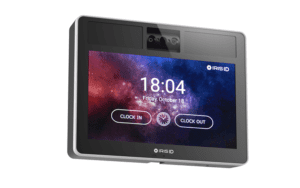
With ISC West is taking place this week, some of the biggest names in biometrics are heading to Las Vegas for the biggest security industry show in the world. And one of the most notable among them that will be in attendance is Iris ID. The biometrics pioneer has a long track record providing iris and face scanning solutions to clients across various sectors, and this year will place a strong focus on border control and air travel applications at ISC West, given the capabilities of its new iCAM D2000 and IrisBar biometric readers.
Naturally, these topics were part of a recent conversation between Iris ID VP Mohammed Murad and FindBiometrics Editor in Chief Peter Counter. But the Iris ID team’s expertise is broad, and Murad offered his insights on a number of other key topics, including the impact of COVID-19 on the biometrics industry, the importance of multi-factor authentication and interoperability, and the critical discourse around privacy and educating the public – with the latter being ‘the biggest challenge’ that the biometrics industry faces. Read the full interview below for insights from one of the industry’s leading experts.
Read the full interview with Mohammed Murad, Vice President, Iris ID:
Peter Counter, Editor in Chief, FindBiometrics: We just published our Year in Review survey results. This was the 19th year that we’ve done it and they’re showing that touchless biometrics are continuing to gain in popularity. So my first question is: how has the growing demand for contactless technology affected Iris ID’s business, and are organizations more interested in iris biometrics now than they were before COVID-19?
Mohammed Murad, Vice President, Iris ID: That’s an interesting question. Of course, COVID-19 throws a curve ball into the contact and contactless biometric business. However, since 2015 and 2016, we’ve seen a regular uptick in the demand for contactless solutions as the biometric technology needs were growing into many areas and many people were starting to interact with devices. Operations people were thinking about how to implement solutions that would be faster, more accurate, touchless, and able to accommodate a large population of users. We are seeing a continuous rise since that period. We see that reflected in our business and the presence in different enterprises with our solutions. But COVID 19 changed the conversation from, “Hey, I want to adopt the new technology,” to, “Hey, I have to adopt the new technology because I want to protect my user population. We don’t want everybody to be touching the same thing.”
At the same time, we want to provide a secure environment with accurate solutions. So that conversation really accelerated the adoption of technology. And we’ve seen that from 2020 into ’21. We entered into other vertical markets and focused on vertical applications, where the touchless solution fits, such as time and attendance. So, we definitely see increased demand for the technology, and we see that it’s not going away. Now the conversation is starting to go more into how to drive contactless technology growth.
Peter Counter, Editor in Chief, FindBiometrics: Just to expand on this point while we’re on the topic: we’re two years into the pandemic and the biometrics industry has seen a lot of changes as a result. It’s really accelerated the digital transformation trends that we were seeing throughout all parts of society in 2020. And, it kind of gave a boost to all different parts of the industry. We have the touchless and contactless part that we just talked about. There’s also the ID verification boom, and identity has really become a core aspect of digital life. What is your opinion on the opportunities and the challenges that are facing biometrics at this point in the pandemic specifically?
Mohammed Murad, Vice President, Iris ID: The most important challenges that biometric technology faces are unrelated to the pandemic. The biggest challenge we face is consumer, supplier, and legislative education – all these entities need to be educated on the value of biometrics and how to use it, when to use it, where to use it. These questions need to be answered for them. And what I see moving forward is the education of how to use biometrics, not what biometrics technology is, by now everybody knows that. We are carrying biometric devices in our pocket, and every day we unlock our phones using our faces or fingers. So, I believe the biggest challenge that our industry has today is the how: how are we going to educate the market, and the entities who are writing the legislation so it’s not going to hurt the technology, but instead allow us to build solutions that are going to enhance the applications for biometrics solutions.
Peter Counter, Editor in Chief, FindBiometrics: The need for that type of education is a massive challenge, and our Year in Review results support that. Would you say the role of privacy plays a large part in that education as well?
Mohammed Murad, Vice President, Iris ID: Absolutely. The education piece around privacy is so important because we need to be able to tell the consumer that using biometrics protects your privacy, it does not invade your privacy. That’s why the use of biometrics, and the dos and don’ts of biometrics needs to be part of that education. We want the consumer feeling comfortable saying, “Yes, this is really the tool and technology that will allow me to protect my privacy.”
For example, if my medical records are protected by biometrics, only I have access to them or the party that I authorize to view. If that sort of education and thought process is built into the educational message, it will enable the growth of the biometrics industry in many different applications.
Peter Counter, Editor in Chief, FindBiometrics: Iris ID recently launched the LightHouse iCAM D2000 and the IrisBar iBar600, both of which are geared toward the travel industry. What makes contactless identification technology so appealing to the travel sector, and why are your solutions well-suited to airports and other high-throughput environments?
Mohammed Murad, Vice President, Iris ID: I’m glad you mentioned high-throughput, because those two technologies are not just designed for travel. They fit very nicely in travel applications like passenger processing to deliver a frictionless consumer experience, but the idea behind those solutions is that we can enable any application that requires high throughput to work at a distance for image acquisition. That allows integration into legacy or future solutions. Take, for example, a kiosk application. IrisBar is designed with a small footprint, so it fits into any ATM, ticketing, guest registration, or hotel check-in kiosk.
The idea is that we built the technology for a frictionless experience and the immediate use case is going to be travel. Right now, the travel industry is very hungry for non-contact, high throughput solutions that are fast and accurate. However, the solution is designed to be applied to many vertical applications. We are seeing that we have customers who are thinking about building our technology into registration kiosks in hospitals and throughout the healthcare sector. We have customers who are considering building it into enterprise access control solutions. They said, “We have a lot of doors where we are going to use your other products, but we have some areas where we need to address high throughput, and we still want non-contact tech that can process authorized personnel quickly with no lines.” So both products are designed for high throughput applications. They can easily fit into legacy kiosk applications, also accommodate very commonly used applications, like access control, aviation, and the transportation sector.
Peter Counter, Editor in Chief, FindBiometrics: I really love to hear about technology like that, which obviously has an immediate place in an industry, but is ready to expand. We see a lot of biometrics specifically like this in travel and hospitality, but biometric ATMs are on the rise too and having a contactless biometric modality there is amazing when it comes to public perception, and addressing the “how” of the education you were talking about earlier. Do you see this as something that will help boost the adoption rate of biometric technologies, particularly iris?
Mohammed Murad, Vice President, Iris ID: Absolutely. I believe any technology that is easy to use will allow us to expand the consumer base. I’ll give you a perfect example. The CLEAR lanes at the airport use Iris ID technology to identify individuals. The adoption of that solution is great because it’s easy to use and the consumer understands the direct benefits. A recent report stated 70 percent of travelers are willing to give their biometrics to enhance their travel experience. When that sort of data comes along you know that biometrics has truly arrived.
Peter Counter, Editor in Chief, FindBiometrics: Many of your solutions, including the two we’ve been speaking about, support both face and iris recognition as a fused biometric. What’s the advantage of combining modalities this way, and should more organizations be trying to switch to a multifactor authentication standard if they want to improve their security?
Mohammed Murad, Vice President, Iris ID: Let’s first respond to the topic of multifactor authentication. Many organizations are looking at the requirements for security and identification, which may require multifactor authentication. The idea is that the higher the security need, the more factors need to apply. We’ve been doing this for a long time; we use PIN, card, and iris – either all three together, or iris as the first factor with the addition of card or PIN. So that’s already there. The bigger question is about multimodal. We always inform our customers that it costs a lot of money to onboard an employee or a citizen for an ID card, so we recommend collecting all the modalities at one time. Bringing people back to re-enroll is expensive.
If the application is forensic in nature, as part of some investigation, you’re not going to use iris and you’re not going to be able to use face, because those two modalities aren’t left behind. But we do leave behind fingerprints, so you use fingerprint biometrics for the investigation. If you are an enterprise and you need to perform employee background checks, those databases have been around for a very long time and are associated with the fingerprint modality. We are seeing a growth in iris databases as well at the FBI so very soon you will see use of iris in background checks. So, it is always advisable that, if you are going through the painstaking exercise of onboarding an individual, you collect all modalities. That way you future-proof the solution. Then, if at any time you want to use a particular modality to identify, you don’t need to think about, “Oh, I need to bring people back – ouch.”
We are in the business of building cameras to acquire an iris image and building software to be able to create a template from that iris image and match it. So, while we have the camera, why don’t we build the optical path allowing us to take the face picture as well? Since we introduced the capture of the face and iris from same device our customers are starting to use our device for face and iris capture and store the iris data for future use if not currently required. It saves time and money.
Our new LightHouse and IrisBar technologies allow you to capture both the face and iris image at the same distance, with the same quality from a single device. Then we went a step further. We built algorithms that allow us to take both of those biometrics in a high throughput environment and raise the level of accuracy by fusing the two modalities. So, I can now be far more confident in getting the results back. These are fused biometrics, so I don’t need to worry about, “Did I capture the highest quality face?” or, “Did I capture the highest quality iris?” I took both. I fused them together and my confidence level in the results is increased.
Peter Counter, Editor in Chief, FindBiometrics: It’s the perfect realization of the biometrics mantra “security and convenience.” You’re doing as much as possible in a single moment, collecting the data and then increasing performance and security by orders of magnitude. You mentioned earlier that we might talk a little bit about time and attendance. Your technology is compatible with a number of different third-party time keeping and access control platforms, as well as with other biometric software providers like Aware. Why is interoperability so important with your products?
Mohammed Murad, Vice President, Iris ID: Interoperability is our absolute goal. We want to make sure that if you have purchased a product from us, or any third party, that you are able to acquire an image – as long as they support the ISO standards. Interoperability is very important to us, and for the growth of the technologies.
You referenced Aware. Middleware vendors build solutions for identity management and identity authentication with biometrics. Their goal is to work with vendors so they can be absolutely sure that they are following all the standards, so their solution and application is interoperable. So, customers’ systems are future-proof. If they needed to ever move from system X to system Y they don’t need to go through the re-enrollment process, which is, as we discussed earlier, is very expensive.
Interoperability is the key for successful solutions in the IT world. It enables two systems to talk to one another. As long as they’re talking in a similar language, they will be able to exchange data and communicate. In the biometric world, interoperability is the core basis. All our products produce images compliant to the ISO standards.
The other question you asked about was the third-party application. We can’t be the final solution. Our goal is to build an ecosystem around our technology, not a solution. That means these third parties are building apps that can execute on our device, and those devices become just like your telephone. You put the app on it, and it fits in a particular vertical market so that a customer can be comfortable saying, “Oh, I can buy this app that runs on this device.” It’s a purpose-build for vertical markets.
Dell makes a Windows-compatible computer and millions of applications that run on the operating system. We took the same approach but on Android. Our vision is to establish an ecosystem of applications that can be supported on our device. And we are seeing that now. The iT100 is about 16 or 17 months in the market, and we have a half dozen to a dozen apps providers focusing on vertical market applications. These apps are very successful, and it gives them an upper hand because now they can customize an app to fit a particular need of their customer rather than just providing them a generic time clock for managing their workforce. A time clock can become a real information provider to the end customer, user, or consumer. If they want to know how many vacation hours they have left, the information can be pushed down to the device upon their request and all that is protected by their biometrics – only accessible when they are in front of the device and they’re requesting it after they’re authenticated.
Peter Counter, Editor in Chief, FindBiometrics: To touch on another hot area: government agencies are increasing their use of contactless biometrics and iris recognition specifically. Why are iris biometrics appealing more to law enforcement and to agencies that run national ID programs?
Mohammed Murad, Vice President, Iris ID: Let’s address law enforcement, first. The FBI, for example, has the biggest criminal database out there. For the last several years they were working on increasing efficiency by applying multimodal biometric technologies. If an officer is booking a person, the officer can now get all of the person’s biometrics at the same time (face finger and iris). And the benefit of iris is speed and accuracy. If they wanted to search those records, they’ll be able to send that information to the central database and be able to find those records quickly without waiting for hours while holding an individual.
On the other side, with national ID, you are looking at identifying people in large countries with millions or billions of people. You need technologies that will allow you to scale up. That means you’re not only dealing with applications that only support a one-to-one verification format. You want technologies that will be able to support one-to-many. And ‘many’ in this case could be millions or billions. You want to have a comfort level that you’re going to hit that accuracy mark, and the confidence level that the results you are getting are six-nines (99.9999 percent) in accuracy.
Peter Counter, Editor in Chief, FindBiometrics: We talked a lot already at the beginning of this interview about the challenges in our industry, but I’m wondering, from your perspective, what are the big opportunities that face biometrics in 2022?
Mohammed Murad, Vice President, Iris ID: I think the biggest opportunity is figuring out how we are going to insert biometric technology into mainstream applications. The success of any technology depends on how quickly people adopt that solution. And that has been the challenge for biometric technology, the adoption into mainstream. We see that changing now, as we just mentioned earlier, with 70 percent of people willing to share their biometrics for better travel experiences. In that scenario it’s the service, it’s the speed of how they can go from the curb to their gate. With biometrics, the whole process becomes easy. The challenge is finding where and how can we insert this technology to make it easy for people to use, so they realize that biometrics technology enhances protection of their privacy, rather than invades it. If this message resonates with the consumer, we will see the opportunity for growth is tremendous.
Peter Counter, Editor in Chief, FindBiometrics: Finally, one last question. What can we expect from Iris ID in the coming year?
Mohammed Murad, Vice President, Iris ID: Very soon we’re going to be talking about the advancements that we are making in the algorithms for matching, counter measures, and acquisition of images. Lots of good stuff is happening, and you will see some new announcements towards the middle of this year on new product lines as well. We’re very excited for 2022 and beyond.
Peter Counter, Editor in Chief, FindBiometrics: Thank you, Mohammed, for joining me today. Always a pleasure to catch-up.
Mohammed Murad, Vice President, Iris ID: It’s always fantastic to work with you guys and talk about the industry, where it’s going, where we are going, and where we think we need to be to make sure that biometric solutions are part of mainstream apps.







Follow Us